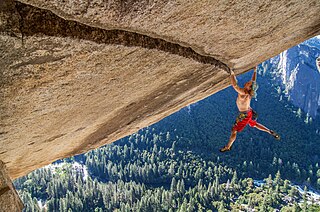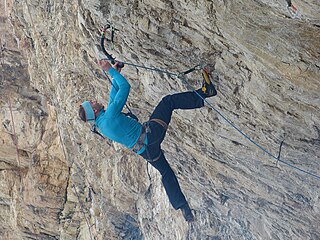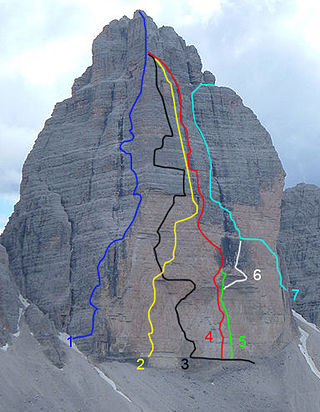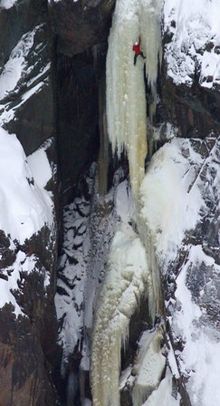
Climbing is the activity of using one's hands, feet, or other parts of the body to ascend a steep topographical object that can range from the world's tallest mountains to small boulders. Climbing is done for locomotion, sporting recreation, for competition, and is also done in trades that rely on ascension, such as rescue and military operations. Climbing is done indoors and outdoors, on natural surfaces, and on artificial surfaces

Mountaineering, mountain climbing, or alpinism is a set of outdoor activities that involves ascending mountains. Mountaineering-related activities include traditional outdoor climbing, skiing, and traversing via ferratas that have become sports in their own right. Indoor climbing, sport climbing, and bouldering are also considered variants of mountaineering by some, but are part of a wide group of mountain sports.

Many climbing routes have a grade that reflects the technical difficulty—and in some cases the risks and commitment level—of the route. The first ascensionist can suggest a grade, but it will be amended to reflect the consensus view of subsequent ascents. While many countries with a strong tradition of climbing developed grading systems, a small number of grading systems have become internationally dominant for each type of climbing, which has contributed to the standardization of grades worldwide. Over the years, grades have consistently risen in all forms of climbing, helped by improvements in climbing technique and equipment.

A climbing route is a path by which a climber reaches the top of a mountain, or rock/ice-covered obstacle. The details of a climbing route are recorded in a climbing guidebook and/or in an online climbing route database, and will include elements such as the type of climbing route, the difficulty grade of the route–and beta on its crux(es)–and any risk or commitment grade, the length and number of pitches of the route, and the climbing equipment needed to complete the route.

An ice axe is a multi-purpose hiking and climbing tool used by mountaineers in both the ascent and descent of routes that involve snow, ice, or frozen conditions. Its use depends on the terrain: in its simplest role it is used like a walking stick, with the mountaineer holding the head in the center of their uphill hand.

Glossary of climbing terms relates to rock climbing, mountaineering, and to ice climbing.

In mountaineering and climbing, a first ascent, is the first successful documented climb to the top of a mountain or the top of a particular climbing route. Early 20th-century mountaineers and climbers focused on reaching the tops of iconic mountains and climbing routes by whatever means possible, often using considerable amounts of aid climbing, and/or with large expedition style support teams that laid "siege" to the climb.

Dry-tooling is a form of mixed climbing that is performed on bare, ice-free, and snow-free, routes. As with mixed climbing, the climber uses ice axes and crampons to ascend the route, but uses only rock climbing equipment for protection; many modern dry-tooling routes are now fully bolted like sport climbing routes. Indoor ice climbing competitions are held on non-ice surfaces and are effectively dry-tooling events.

Solo climbing, or soloing, is a style of climbing in which the climber climbs a route alone, without the assistance of a belayer. By its very nature, it presents a higher degree of risk to the climber, and in some cases, is considered extremely high risk. Note that the use of the term "solo climbing" is generally separate from the action of bouldering, which is itself a form of solo climbing, but with less serious consequences in the case of a fall. The most dangerous form of solo climbing is free solo climbing, which means both climbing alone and without any form of climbing protection.

Yvon Chouinard is an American rock climber, environmentalist, philanthropist, and outdoor industry businessman. His company, Patagonia, is known for its commitment to protecting the environment. He was named one of the 100 most influential people in the world by Time magazine in 2023.

In the history of rock climbing, the three main sub-disciplines—bouldering, single-pitch climbing, and big wall climbing—can trace their origins to late 19th-century Europe. Bouldering started in Fontainebleau, and was advanced by Pierre Allain in the 1930s, and John Gill in the 1950s. Big wall climbing started in the Dolomites, and was spread across the Alps in the 1930s by climbers such as Emilio Comici and Riccardo Cassin, and in the 1950s by Walter Bonatti, before reaching Yosemite where it was led in the 1950s to 1970s by climbers such as Royal Robbins. Single-pitch climbing started pre-1900 in both the Lake District and in Saxony, and by the late-1970s had spread widely with climbers such as Ron Fawcett (Britain), Bernd Arnold (Germany), Patrick Berhault (France), Ron Kauk and John Bachar (USA).

Dave MacLeod is a Scottish rock climber, ice climber, mixed climber, and climbing author. MacLeod was the second-ever person free solo a 8b+ (5.14a) graded route, and for climbing one of the hardest traditional climbing routes in the world.

An ice tool is a specialized elaboration of the modern ice axe, used in ice climbing, mostly for the more difficult configurations. Ice tools are used two to a person for the duration of a pitch, and thus in some circumstances such as top-rope-anchored climbs, a pair may be shared among two or more people, where only one of them at a time is climbing. In contrast a classical "ice axe" is used one to a person for the hours or days a party is traveling across snow or glacier. In communities where it is common to refer to an "ice tool" simply as an "ice axe", classic "ice axes" are often referred to as "traveling axes", "walking axes", or "general mountaineering axes" to distinguish them from "tools".

In climbing, a topo is a graphical representation of a climbing route. Topos range from a photograph of the climb on which the line of the route is overlaid, to a detailed diagram of the key features and challenges of the climb.

Mixed climbing is a climbing discipline used on routes that do have not enough ice to be pure ice climbs, but are also not dry enough to be pure rock climbs. To ascend the route, the mixed climber uses ice climbing tools, but to protect the route, they use traditional or sport rock climbing tools. Mixed climbing can vary from routes with sections of thick layers of ice and sections of bare rock to routes that are mainly bare rock but which is “iced-up”.

Alpine climbing is a type of mountaineering that involves using any of a broad range of advanced climbing skills, including rock climbing, ice climbing, and/or mixed climbing, to summit typically large routes in an alpine environment. While alpine climbing began in the European Alps, it is used to refer to climbing in any remote mountainous area, including in the Himalayas and in Patagonia. The derived term alpine style refers to the fashion of alpine climbing to be in small lightly-equipped teams who carry all of their own equipment, and do all of the climbing.
Tim Emmett, is a British-born adventure climber and climbing author. He is known for his participation in a diverse range of climbing disciplines, including ice-climbing, rock climbing, deep-water soloing and alpine climbing. Emmett has established the hardest waterfall ice-climbs in the world, and was the first to climb grades of W10 and above.

Mount Wilson is a 3,260-metre (10,696 ft) mountain summit located in the North Saskatchewan River valley of Banff National Park, in the Canadian Rockies of Alberta, Canada. Its nearest higher peak is Mount Cline, 9.81 km (6.10 mi) to the northeast. Mount Wilson is situated immediately north of the confluence of the North Saskatchewan River, Mistaya River, and Howse River near Saskatchewan Crossing, where the Icefields Parkway intersects with the David Thompson Highway.

Mount Murchison is a 3,348-metre (10,984 ft) mountain summit located at the convergence of the North Saskatchewan River valley and Mistaya River valley of Banff National Park, in the Canadian Rockies of Alberta, Canada. The main summit has two high points: the Southeast Peak is 3,348 m, whereas the Northwest Peak is 3,333 m and separated by 700 m distance. Its nearest higher peak is Mount Cline, 15.71 km (9.76 mi) to the north. Mount Murchison is situated immediately southeast of the confluence of the North Saskatchewan River, Mistaya River, and Howse River near Saskatchewan Crossing, where the Icefields Parkway intersects with the David Thompson Highway.

The Alpinist is a 2021 American documentary film directed by Peter Mortimer and Nick Rosen about Marc-André Leclerc, a free-spirited and little-known 23-year-old Canadian rock climber, ice climber, and alpinist. From 2015 to 2016, a film crew followed Leclerc as he solo climbed some of the most difficult and dangerous alpine climbing routes in the world.















![Angelika Rainer [it] high up on the severely overhanging Clash of Titans (WI10+), Helmcken Falls. Angelika Rainer Helmcken Falls 3.png](http://upload.wikimedia.org/wikipedia/commons/thumb/5/51/Angelika_Rainer_Helmcken_Falls_3.png/220px-Angelika_Rainer_Helmcken_Falls_3.png)
![Pak Hi-jong [cs] on Tequila Stuntman (M7 WI6) in Chamonix, France Hee Yong Park and Hannarai Song on "Tequila Stuntman" in Chamonix 2.png](http://upload.wikimedia.org/wikipedia/commons/thumb/7/7c/Hee_Yong_Park_and_Hannarai_Song_on_%22Tequila_Stuntman%22_in_Chamonix_2.png/220px-Hee_Yong_Park_and_Hannarai_Song_on_%22Tequila_Stuntman%22_in_Chamonix_2.png)




















